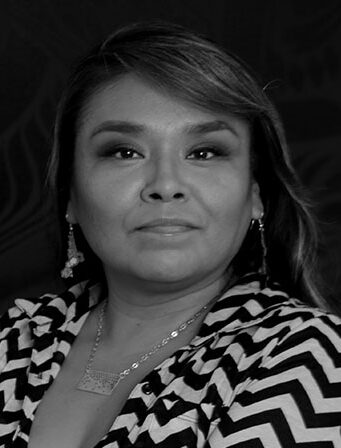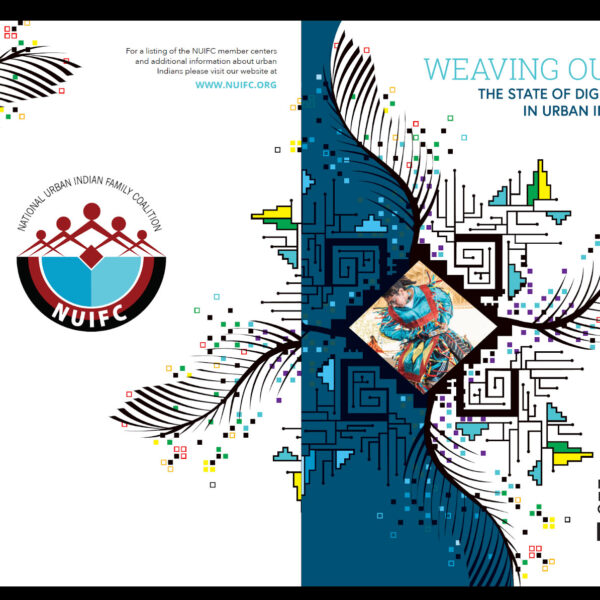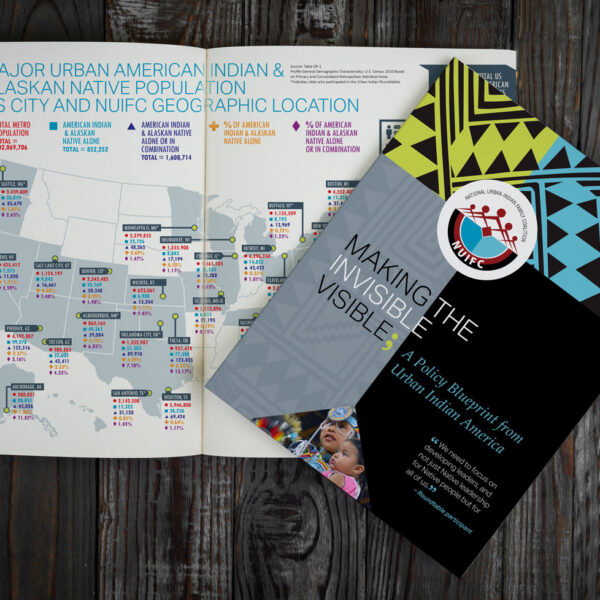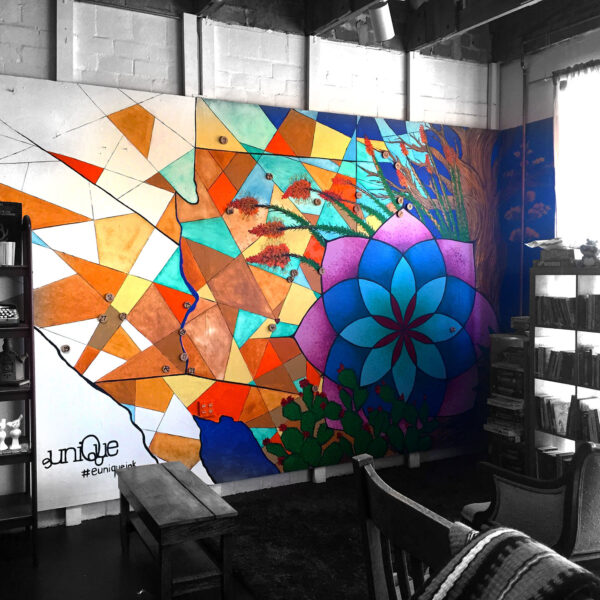04 Mar Member Spotlight: Eunique Yazzie, Indigenous Designer and Activist

Bridging the Gap
Eunique Yazzie imparted a few suggestions of how non-indigenous designers can support the indigenous community:
- Hire indigenous businesses.
- Shop local and support indigenous social enterprises and brands.
- Read and watch books and films recommended by the indigenous community.
- Volunteer your time to Indigenous community events or gatherings.
- Donate to Indigenous co-ops and organizations.
- Vocalize Indigenous perspectives and the issues Indigenous communities are facing, and communicate those concerns to leadership – be a change agent.
- Keep learning and engage in proactive learning within indigenous communities – it’s a continuous learning cycle
Learn our history, walk on the journey with us. Native communities are under attack today. Missing and Murdered Indigenous Peoples, Protecting the Sacred, Water is Life, Food Sovereignty — these are some of the issues we are elevating through our work. These issues no longer just affect the native community; they are spreading into other marginalized communities. Know what lands you’re on; no matter where you are, you are on Native land.
Guild member Eunique Yazzie is an indigenous designer who grew up in Flagstaff, South Dakota, and in Chinle, Arizona, on Navajo Nation land. She’s a graphic designer, social entrepreneur, poet and story teller. More importantly, she is an activist who gives back to her community (and ours) by elevating indigenous culture and designers, educating non-indigenous designers, and building community.
What Eunique Yazzie wants most is, “To be seen as an Indigenous professional working to shine a light on the Indigenous perspective in creative fields ” And Eunique does just that. As a professional graphic designer she has continually worked hard towards achieving her goals – as both an Indigenous designer and a creative advocate. Those two roles are hand-in-hand with her values and achievements. Eunique has worked mostly with local businesses in the Arizona community and has completed national work for Native organizations. She continues to work with creatives in the community, dedicating herself to being a driving force in the Phoenix area, and an inspiration to her fellow artists, designers, and creatives in the community.
Developing a Career as an Advocate
Wanting to quickly fulfill her grandmother’s dream for her of ““getting an education, and bringing it back home”, Eunique earned her bachelor’s degree in Visual Communication at a local community college. Her first jobs – providing comprehensive design services to a company contracting with Arizona State University, and working in direct mail print production and online storefront development for The Arizona Republic – gave her a solid foundation in both print and digital design and workflow skills. However, it was her work with the indigenous community that grounded her in advocacy work.
Among the projects she developed for indigenous clients are rebranding the Phoenix Indian Center and designing publications for the Native Urban Indian Family Coalition, which represents 40+ trusted community-based nonprofit organizations across 23 states.The infographics she created for the organization visualized data collected on urban indigenous communities nationwide, and were critical for communicating the needs of the indigenous communities and directing policy funding from Congress.
After working for a civil engineering firm and learning about how their consulting work shapes communities in cities, states, and territories, Eunique created her own creative development consulting firm, euniQue, LLC. As a social entrepreneur, she began working with businesses and clients that were aligned with her values: “There was a significant amount of creative opportunities but little to no Indigenous representation. I began making connections to the Roosevelt Row Arts District and it was there where I found my voice.”
An Indigenous Design Advocate
Her work as an advocate has taught her to recognize when voices are being challenged, and see when change is happening around her:
I knew I was hacking a system that was built to keep voices like mine quiet. The system did not want my words to land on the places we were removed from as native peoples. My bold tone, brown skin, and loud presence echoed in spaces where culture informed place, heart break, and historic suffering and yet – I thrived resiliently engaging crowds and creating art that would touch people’s minds and hearts. I had found my way back to performance and the stage and it was healing me in ways I couldn’t have imagined…
While working [with] different teams, cooperation is often masked as collaboration. I started speaking as a community advocate, speaking from my heart, educating people about Indigenous perspectives. In order to design a life where we are equitably treated with respect and valued for our contributions to society a shift in mindsets and perspectives is needed…. We are able to make the choice to see another person’s viewpoint, and I saw purpose in creating space where that could happen.
Creativity from an Indigenous Perspective
As an indigenous designer, Eunique brings a valuable cultural perspective to the creative development and the design process that is rarely heard:
In the westernized perspective, everything is linear, how you shape your life choices, career, goals, and more. The linear approach sees things in a line, how to get to point C by passing through points A and B. Creativity is not valued and is conditioned out of us at a young age while we pass through our grade levels to get to some sort of achievement. We are instructed to follow a path that looks like the ‘American Dream’. This perspective is much different from that of Indigenous worldviews. As an Indigenous woman in the design field, I can now see where my thought process came from.
My creativity was my super power and it was passed down from my ancestors. We saw problems not as roadblocks but as learning lessons and that is the foundation of circular thinking. We took the time to understand how an issue affects us as humans and our communities then used our resources to build and prototype solutions.
Once a solution worked we shared it with the world by way of pre-colonial trade routes to sustain life and their ecosystems that influenced them. We cultivated, developed, and engineered ideas long before these colonial capitalistic worldviews displaced our people. I believe Indigenous peoples and their perspective have an important place in how we envision our future together. But we must first face historic truths of genocide, displacement, cultural mis-appropriation and the many other topics hidden from student history books.
She also identifies the unwitting damage non-indigenous designers do with inaccurate or stereotypical representations of indigenous culture:
When companies want to acknowledge something like Native American Heritage month or an event recognizing Indigenous peoples, they turn to stock photography and graphics to visually communicate the purpose. The task is usually assigned to a non-indigenous designer, who may have only learned of Indigenous people through movies or inaccurate references in their life. This often leads to outputs of feathers, dream catchers, and teepees placed among text.
By using stock images or ideas of non-indigenous designers, not created by an Indigenous person, who are you honoring and recognizing?… This disconnection of equitable approaches to design perpetuates harmful stereotypes and by doing so enables cultural mis-appropriation. There are 574 tribal communities and countless other non-recognized Indigenous communities that exist in the US, that have different languages, cultures, belief systems and historic references of people and land. A dreamcatcher and feather inaccurately simplifies our existence…The design industry re-enforces one perspective, and the non-Indigenous designer who took on the task did not research who, where, what or how they honoring Indigenous peoples.
Educating the Non-Indigenous, Elevating the Indigenous
Eunique believes in educating the non-indigenous designer and providing opportunities for indigenous creators. She founded the platform Indige Design Collab to meet these goals. The Indige Design Collab website and social media educate non-indigenous designers on indigenous projects and provide an avenue to learn more about and hire indigenous designers:
With the many self-taught and educated designers we collaborate with, we connect them with opportunities that allow them to elevate their stories with their skill sets… In our design projects, we know we bring our full selves into the project. A true collaboration allows for designers to come together in a shared goal in an autonomous way. That’s what indigenous design is, and was established by the indigenous community practices.
Our Indigenous collaborators and designers are aware of cultural designs and are creating relevant, modern ideas to communicate their perspectives as a way of representation.
Eunique has worked with many indigenous designers including, Jeremy D. Arviso a multimedia designer and artist from the Phoenix area, had this to say about her:
Eunique is a colleague and we’ve worked together on a few different projects, collaborations and events together. We like to bounce ideas off each other and what I like best is getting a woman’s perspective on design. It’s something I’ve never seen, first off, because I’m a man, second, design tends to be taught and instructed from a masculine approach in the western world. Indigenous design is inherently matriarchal in nature and that’s what Eunique is very keen on. Her ability to see data in everything around her and then translate it into design is a very powerful skill most men can’t comprehend.
Indigenizing Spaces
Eunique Yazzie has also partnered with Melody Lewis as Co-Founders of a second online platform, Cahokia: SocialTech & ArtSpace. Cahokia is an online platform for creative placekeeping, a place Eunique describes as “a place where we can connect our worldviews to urban ideas as we share the mission to Indigenize space.”
In creating this space, Cahokia is addressing Arizona’s troubling history of suppressing indigenous cultures. Even after achieving statehood in 1945, acceptable rhetoric in Arizona included the racist slogan, “Kill the Indian, Save the man”. The historic quote dates back to when widespread policy in the US supported cultural genocide, and members of indigenous communities were even killed for practicing their ceremonies and speaking up for their communities. Eunique’s goal in creating Cahokia was to “stand and create thought-provoking work in the places where my ancestors were not able to go…We want to indigenize space and activate communities to share our stories.”
Cahokia is committed to collaborating with local businesses, organizations and entrepreneurs to host community events that celebrate and accurately reflect indigenous culture. For example, for Indigenous Peoples’ Day, Cahokia worked with over 100 collaborating companies, vendors, and restaurants to bring Indigenous Peoples’ Day Phoenix Fest. The Roosevelt Row Arts District in Phoenix was closed off for the event where native foods, activities, demonstrations, art and live music invigorated the area. The celebration was a huge success and brought about awareness, appreciation, and a feeling of unity:
A ripple creates a wave that others can see, hear, and feel. That is what we want to create. A wave to shift perspective.



